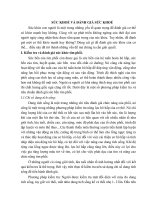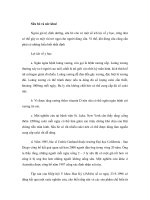Quý Đơn vị lời chào trân trọng nhất và chúc Quý Đơn vị thật nhiều sức khỏe.
Bạn đang xem bản rút gọn của tài liệu. Xem và tải ngay bản đầy đủ của tài liệu tại đây (73.9 KB, 7 trang )
Intro to Business - Chapter 8
HÍc trđc tuy¿n t¡i />
1. Work Force
16 years or older employed or looking
-150 million
2. Occupational
Outlook
Handbook
Offers up-to-date information about the US workforce
3. Two Major types 1) Goods-Producing industries: Businesses that
of industries
produce or manufacture products used by other
businesses or purchased by final consumers
2) Service Providing Industries: Businesses that
perform services that satisfy the needs of other
businesses and consumers
4. Two Broad types WHITE Collar: More MENTAL than PHYSICAL
of Occupations -Involve handling & processing of information
BLUE Collar: More PHYSICAL
-Operation of machinery & equipment or other
production activities
5. Influences of
Work Force
or
Changing Job
Requirements
Consumer Preference: Dollar
Business Cycle: Stages
New Technology
Business Competition
Down Sizing
Outsourcing
6. Down Sizing
The planned reduction in the number of employees needed in a firm in order to reduce costs and make the business
more efficient
7. Outsourcing
Removes work from one company and sends it to another
company that can complete it at a lower cost
8. Human Resources
People producing goods & services
People who work for a business
9.
1/7
Intro to Business - Chapter 8
HÍc trđc tuy¿n t¡i />
Human Resource 1) Identify Personnel needs of the company
Dept. Goals
2) Maintain a supply of workers to fill those NEEDS
3) Match abilities & interest to the specific job
4) Training & Development
5) Plans to compensate personnel for their work
6) Protect Health & well-being of employee
7) Safe & Productive/Satisfying Environment
10. Human Resource 1) Planning & Staffing
Activities
2) Evaluate Performance
(PS EP CB SE)
3) Compensation & Benefits
4) Safe Environment
11. Classifying Employees
Full Time
Part Time
Permanent
Temporary
Long Term Commitment
Specific Job
12. Full TIme
Regularly works 30 hours or more per week
13. Part TIme
Fewer hours per day or fewer day per week
Part time Employee: One who works a schedule
with either fewer hours each day or fewer
than 30 hours each week
14. Permanent
Permanent Employee
15. Temporary
Company makes a long term commitment
Permanent Employee: One to whom the company
makes a long term commitment. it is
expected that the employee will work for the
business as long as the business is profitable
and the employee's performance is
satisfactory
Hired for a specific time or specific project
16. Job Analysis
2/7
Intro to Business - Chapter 8
HÍc trđc tuy¿n t¡i />
Determining job requirements:
Specific study of a job to identify in detail the job duties
and skill requirement
17. Recruiting & Hir- 1) Application Process: Application, PDS, & Resume
ing
2) New employee orientation
18. Compensation & The human resource activity involving planning & manBenefits
aging PAYROLL, PERSONNEL RECORDS, & BENEFITS
programs
1) Compensation:
2) Salary & Wages:
3) Benefits
19. Compensation
The amount of money paid to an employee for work performed, including salary & wages
20. Salary and
Wages
Direct payment of money to an employee for work completed
21. Benefits
Compensation in forms other than direct payments
**Company's put 20-40% towards benefits
Ex's: Health or Dental Insurance
22. Compensation
-Time Wage
Methods (TW SS -Straight Salary
IS)
-Incentive Systems: (CPB)
-Commission
-Piece Rate
-Base plus incentive
23. Time Wage
A specific amount paid to an employee for each hour
worked
24. Straight Salary
A SPECIFIC amount of money paid to an employee for
each hour worked
25. Incentive Systems
Compensation systems connected to the quality or quantity of an employee's performance
3/7
Intro to Business - Chapter 8
HÍc trđc tuy¿n t¡i />
26. Commission
The amount of money paid based on a PERCENTAGE of
sales for which he or she is responsible.
**The fee stockbrokers charge for their services
27. Piece Rate
A pay-for-performance plan in which an employee receivers a specific amount for each unit of work
28. Base Plus Incen- A compensation system which combines a wage or salary
tive
with an additional amount based on the employee's performance
29. Employee Bene- -Required
fits
-Other Benefits
30. Performance
Management
Evaluating the work of employees and improving performance through training and development
31. Employee Evalu- -The evaluation process
ation
-The evaluation conference
-Promotions, Transfers & Terminations
32. Promotions
The advancement of an employee to a position with
greater responsbility
33. Transfers
The assignment of an employee to another job in the
company with similar level of responsibility
34. Terminations
The END of an employment relationship between a company & an employee
Discharge (A
type of termination)
Discharge: Ends employment due to inappropriate
behavior
Layoff (A type of Layoff: A temporary or permanent reduction in the
termination)
number of employees due to changing
business conditions
35. Effective Culture -Organization Culture
-Work Environment
4/7
Intro to Business - Chapter 8
HÍc trđc tuy¿n t¡i />
36. Organizational
Culture
The environment in which people work,
made up of..
1) The atmosphere
2) Behaviors
3) Beliefs
4) Relationships
37. Work Environment
1) The PHYSICAL conditions
2) PSYCHOLOGICAL atmosphere
**In which employees work**
38. Work - Life Rela- 1) Personal Time
tionships (Pt Fl Ft 2) Family Leave
Js Fp)
3) Flextime
4) Job Sharing
5) Flexplace
39. Personal Time
A few hours each month that can be scheduled for non-job
activities
40. Family Leave
A policy that allows employees to take a leave of absence
Family Leave Pol- for the birth or adoption of a child, to care for a sick family
icy
member, or for other personal emergencies
41. Flextime
A program that allows employees some choice in how their
work days and work hours are arranged
42. Job Sharing
An arrangement in which ONE job is offered to TWO
people.
-Each person works a part-time schedule.
-They share the work space and duties of the job
43. Flexspace
A program that allows some employees to complete part
or all of their work AWAY from the business site
44. Employer-EmManagers and employees that work together, find ways
ployee Relations to accomplish the goals of both the organization and the
individuals who work for it
5/7
Intro to Business - Chapter 8
HÍc trđc tuy¿n t¡i />
**Responsible for maintaining a safe, healthy, & productive
work environment for all employees
45. Labor Union
An organized group of employees who negotiate with employers about issues, such as wages and working conditions
46. Collective Bargaining
Formal negotiation between members of the union and
management
47. History of Labor -1940's & 1950's - more than 1/3 of US labor force
Unions
was unionized
-1970's - US economy moved from a goods
producing to a service providing economy
- Employment in heavily unionized industries
declined
-Currently - Employees working as union employees
is approximately 12%
48. Diversity
The comprehensive inclusion of people with DIFFERENCES in personal characteristics and attributes
**Helps at the job, for the individual & society in
general
49. Glass Ceiling
A artificial limit placed on minority groups moving into
positions of authority and decision-making
50. Cafeteria Plan
An employee benefit program that allocates a certain
amount of money to each employee that can be spent on
benefits
51. Planning &
Staffing Activities
Activities directed at identifying & filing all of the jobs in the
company with qualified people
52. Technology
6/7
Intro to Business - Chapter 8
HÍc trđc tuy¿n t¡i />
The use of automated machines, electronic equipment, &
integrated computer systems to help increase the efficiency of producing goods & services
53. Promotion
The advancement of an employee for work completed
7/7









